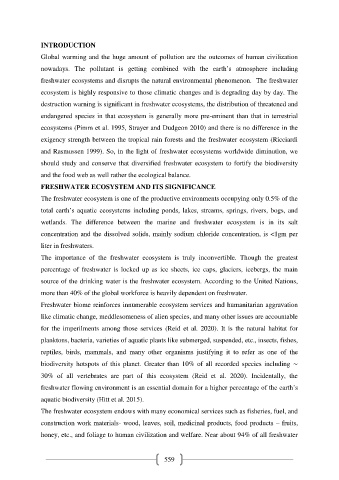Page 569 - e-Book
P. 569
INTRODUCTION
Global warming and the huge amount of pollution are the outcomes of human civilization
nowadays. The pollutant is getting combined with the earth’s atmosphere including
freshwater ecosystems and disrupts the natural environmental phenomenon. The freshwater
ecosystem is highly responsive to those climatic changes and is degrading day by day. The
destruction warning is significant in freshwater ecosystems, the distribution of threatened and
endangered species in that ecosystem is generally more pre-eminent than that in terrestrial
ecosystems (Pimm et al. 1995, Strayer and Dudgeon 2010) and there is no difference in the
exigency strength between the tropical rain forests and the freshwater ecosystem (Ricciardi
and Rasmussen 1999). So, in the light of freshwater ecosystems worldwide diminution, we
should study and conserve that diversified freshwater ecosystem to fortify the biodiversity
and the food web as well rather the ecological balance.
FRESHWATER ECOSYSTEM AND ITS SIGNIFICANCE
The freshwater ecosystem is one of the productive environments occupying only 0.5% of the
total earth’s aquatic ecosystems including ponds, lakes, streams, springs, rivers, bogs, and
wetlands. The difference between the marine and freshwater ecosystem is in its salt
concentration and the dissolved solids, mainly sodium chloride concentration, is <1gm per
liter in freshwaters.
The importance of the freshwater ecosystem is truly inconvertible. Though the greatest
percentage of freshwater is locked up as ice sheets, ice caps, glaciers, icebergs, the main
source of the drinking water is the freshwater ecosystem. According to the United Nations,
more than 40% of the global workforce is heavily dependent on freshwater.
Freshwater biome reinforces innumerable ecosystem services and humanitarian aggravation
like climatic change, meddlesomeness of alien species, and many other issues are accountable
for the imperilments among those services (Reid et al. 2020). It is the natural habitat for
planktons, bacteria, varieties of aquatic plants like submerged, suspended, etc., insects, fishes,
reptiles, birds, mammals, and many other organisms justifying it to refer as one of the
biodiversity hotspots of this planet. Greater than 10% of all recorded species including ∼
30% of all vertebrates are part of this ecosystem (Reid et al. 2020). Incidentally, the
freshwater flowing environment is an essential domain for a higher percentage of the earth’s
aquatic biodiversity (Hitt et al. 2015).
The freshwater ecosystem endows with many economical services such as fisheries, fuel, and
construction work materials- wood, leaves, soil, medicinal products, food products – fruits,
honey, etc., and foliage to human civilization and welfare. Near about 94% of all freshwater
559

